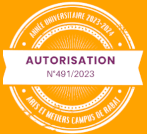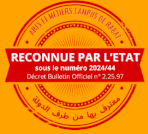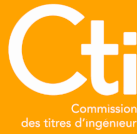07/11/2022
Vers l’asservissement du pilotage en énergie d'une opération de forgeage : développement d'un métamodèle prédictif pour un jumeau numérique
Authors :
URIBE, David
DURAND, Camille
BAUDOUIN, Cyrille
BIGOT, Régis
Publisher : Association Française de Mécanique
In the aeronautical sector, because parts are mainly of large dimensions and in high performance materials, products are forged in small batches. Forming these complex parts requires energy-controlled production means, such as screw presses or, more generally, forging hammer.
With these machines, several successive strokes are necessary to obtain the parts desired geometry and mechanical characteristics. However, for these small quantities, the automation of the manufacturing process is not necessarily possible or profitable and consequently, the control of the machine remains dependent on the know-how of the operators, in particular with regard to the quantity of energy to be delivered blow after blow, the temperature, the lubrication conditions, etc.
The main challenge is to provide flexibility and robustness particularly adapted to small batches, thus limiting the impact of process parameters variability on the part final quality. To reach that goal, the implementation of a digital twin is proposed. The objective of the project is to develop a digital twin in the context of forming materials on an energy-controlled screw press. The scientific challenge is to obtain an accurate, predictive and reactive twin that will allow real-time control of the process as well as access to information that cannot be measured during the manufacturing process.
A methodology for the creation of a predictive meta-model based on a calibrated numerical simulation and updated by machine learning is proposed. This meta-model will compose the digital twin. Our approach is validated on a case study: the uni-axial compression of a copper cylinder. Finally, the following development phases of the digital twin are presented.
+
07/11/2022
An investigation of design in virtual reality across the variation of training degree and visual realism
Authors :
FLEURY, Sylvain
DUPONT, Laurent
CHANIAUD, Noémie
TAMAZART, Saadallah
POUSSARD, Benjamin
GORISSE, Geoffrey
RICHIR, Simon
Publisher :
Research showed that immersive technologies can significantly improve the design process. However, it is important to consider the ease of implementation of solutions (e.g. price, simplicity). Therefore, the objective of this study was to analyze the uses of two types of virtual environments that are relatively simple to implement: a basic model of a room and its 3D scan. Participants made sketches using a virtual reality application, provided by the instructors, in each of the two different VR environments. The sketches are proposals to a furniture co-creation task. Results indicate a better co-creation process during the second session than during the first, which reveals that training is an important criterion in this case. Furthermore, co-creation is felt to be better in the case of the modeled place compared to the 3D scan. This result could be due to the presence of useless virtual objects that can cause a distraction to the participants. These results are discussed from an applicative standpoint.
+
07/11/2022
Etude de l'Influence du Stress sur la Créativité dans un Scénario en Réalité Virtuelle
Authors :
HOUZANGBE, Samory
ANTONIO GOMEZ JAUREGUI, David
FLEURY, Sylvain
HUET, Loïc
BERDON, Léo
MANUSSET, Baptiste
SUBERT, Paul
PIGREE, Jean-Baptiste
COUTURE, Nadine
RICHIR, Simon
Publisher :
Whether it is for evolution, competitiveness or problem solving, innovation is necessary to a company’s survival. Thus, it is essential to understand this process and what affect them to improve innovation. In this paper we focus on the ideation steps (generating ideas and proposing new concepts). We developed an experimental protocol in Virtual Reality, as it has been demonstrated to be a useful medium for creativity. We conducted the experiment following two conditions, one with an induction of stress and one without, to evaluate the effect of stress on the level of creativity. The levels of stress, creativity and physiological signals have been monitored. Our early results did not show significant differences between the two groups, however, as supported by previous studies, we have successfully used the Empatica E4 physiological wearable in our experimental context and observed a general rise in electro-dermal activity (EDA) among our participants. We suggest that our experiment was able to elicit an emotional response in our participants that is observable in the physiological data. This preliminary study will help us shape the next steps of our research on the understanding of the creativity experience depending on different parameters.
+
07/11/2022
Le rôle de l'effacement dans l'activité d'esquisse en réalité virtuelle
Authors :
FLEURY, Sylvain
HENRY, Gaëtan
JEGO, Jean-François
CHEN, Chu-Yin
RICHIR, Simon
Publisher :
Dans son ouvrage sur les processus de conception, Buxton (2007) indique que la réalisation d’esquisses et leurs modifications doivent être faciles et rapides car il s’agit de s’autoriser des erreurs (des idées mal représentées par exemple) et leurs corrections. Buxton indique aussi que les esquisses devraient être intentionnellement ambiguës, afin d’éviter les fixations précoces des idées. La notion d’erreur et de correction n’est donc pas si claire dans ce processus. Dans une étude de Christie et al. (2020), les participants utilisaient moins la fonction d’effacement dans une tâche de dessin sur tablette que sur papier, sans pour autant que cela n’affecte la qualité du résultat. Ils semblent s’adapter à l’outil qui leur est proposé et l’effacement n'apparaît pas ici comme un élément central. Partant de cette idée, nous avons pris le contrepied des recommandations classiques sur les outils de création, afin d’analyser les conséquences sur l’activité de la suppression de la fonction “effacer” d’un outil de dessin.
+
07/11/2022
Comparing Creativity, User-experience and Communicability Linked to Digital Tools during the Fuzzy Phases of Innovation
Authors :
MILLE, Charles
CHRISTMANN, Olivier
FLEURY, Sylvain
RICHIR, Simon
Publisher : SCITEPRESS - Science and Technology Publications
Innovation is defined by a range of activities having different goals but driven by the same purpose. For example, in the ending phases, the aim will be to put forward precise concepts, while upstream of innovation, the activities are defined by the will to investigate the subject and increase the area of knowledge and concepts helpful for the conception of new products. This study takes place in the latter contexts because these are the ones where tools are the most variable and de facto, the least normalised. Our aim was to study user experience felt by the usage of these tools as well as their impact on creativity and ideas’ communicability. To do this, we led an experimental study with 79 participants comparing four tools: pen & paper, Virtual-Reality (VR) drawing, VRCAD, and traditional CAD. Thanks to the UEQ (Laugwitz et al., 2008) and judges method of Cropley and Cropley (2008), we measured the user-exprience and the creativity. Then we compared the level of creativity, user-experience and communicability induced by each tool. The results reveal that the user experience arising from the tool influences the amount and the quality of the ideas. Moreover, we show that the fewer standardises interactions the tools have, the greater the communicability of ideas.
+
07/11/2022
Is virtual reality the solution? A comparison between 3D and 2D creative sketching tools in the early design process
Authors :
HOUZANGBE, Samory
MASSON, Dimitri
FLEURY, Sylvain
GÓMEZ JÁUREGUI, David Antonio
LEGARDEUR, Jeremy
RICHIR, Simon
COUTURE, Nadine
Publisher : Frontiers Media SA
Creativity is key in the early phases of innovation processes. With the rapid evolution of technologies, designers now have access to various tools to support this activity. Virtual reality (VR) takes over multiple domains, especially during conception. However, is VR really facilitating creativity in the initial ideation phases? We compare two sketching modalities through dedicated creativity support tools (CSTs): one in VR and one on a 2D interactive whiteboard. We propose a two-part creativity task (divergent and convergent thinking) for two groups of 30 participants each. We record user experience, creative experience, and creative performance. Our results show that VR is more stimulating, attractive, and engaging. We also observe a better level of creativity for the participants using the VR CST. Our results indicate that VR is an effective and relevant tool to boost creativity and that this effect might carry over to following creative tasks.
+
28/10/2022
Text input tools’ complementarity in immersive virtual environments
Authors :
AGNES, Aurélien
FLEURY, Sylvain
AUZERAIS, Aristide
BISSON, Isaline
DULAU, Eva
BUISINE, Stéphanie
RICHIR, Simon
Publisher :
This study presents a user test in order to ascertain the advantages and disadvantages of three different text input methods in immersive virtual environment: individual Speech-to-Text, collective Speech-to-Text and a virtual keyboard named Drum-Like Keyboard. We measured participants’ user experience, especially related to usability and utility, in order to offer relevant recommendations to people seeking to integrate text input in virtual reality. Our results show that Speech-to-Text and the virtual keyboard have complementary qualities, which can be used together for optimal results and experience.
+
28/10/2022
What are the Challenges and Enabling Technologies to Implement the Do-It-Together Approach Enhanced by Social Media, its Benefits and Drawbacks?
Authors :
PALLOT, Marc
FLEURY, Sylvain
POUSSARD, Benjamin
RICHIR, Simon
Publisher : Cairn
Inspired by the Do-It-Yourself (DIY) movement, the Do-It-Together (DIT) collaborative approach was successfully trialed in 2018, hence opening the door to the application of User Driven Innovation for realizing product individualization. In the meantime, other megatrends like digitization, social media, sustainability, the circular economy, and collaborative consumption have pushed toward a renewed DIT approach for tackling social and societal issues. This article reports on an exploratory study dedicated to the identification of challenges and enabling technologies to implement the DIT approach, as well as its benefits and drawbacks. This study is based on an extensive literature review that allowed us to identify 162 articles resulting in 38 most relevant selected articles and seven Product Life-Cycle (PLC) stages. Based on these PLC stages, all identified DIT challenges, benefits and drawbacks were collected from previous empirical work described in the selected articles. In terms of findings, relevant DIT challenges, benefits and drawbacks are consolidated in distinct tables with proper references. Regarding the enabling technologies for DIT implementation, only immersive technologies at the earlier PLC stage are addressed. The implementation analysis within other PLC stages and enabling technologies like Additive Manufacturing, Big Data, Artificial Intelligence and IoT have to be carried out in order to identify their particular benefits and drawbacks; however, this analysis is left to future work. This study has also revealed a lack of empirical studies addressing negative impacts while there is a plethora of published studies focusing solely on positive impacts.
+
28/10/2022
Geometric Over-Constraints Detection: A Survey
Authors :
HU, Hao
KLEINER, Mathias
PERNOT, Jean-Philippe
ZHANG, Chao
HUANG, Yanjia
ZHAO, Qian
YEUNG, Sunny
Publisher : Springer Science and Business Media LLC
Currently, geometric over-constraints detection is of major interest in several diferent felds. In terms of product development
process (PDP), many approaches exist to compare and detect geometric over-constraints, to decompose geometric systems, to
solve geometric constraints systems. However, most approaches do not take into account the key characteristics of a geometric
system, such as types of geometries, diferent levels at which a system can be decomposed e.g numerical or structural. For
these reasons, geometric over-constraints detection still faces challenges to fully satisfy real needs of engineers. The aim of
this paper is to review the state-of-the-art of works involving with geometric over-constraints detection and to identify pos sible research directions. Firstly, the paper highlights the user requirements for over-constraints detection when modeling
geometric constraints systems in PDP and proposes a set of criteria to analyze the available methods classifed into four
categories: level of detecting over-constraints, system decomposition, system modeling and results generation. Secondly, it
introduces and analyzes the available methods by grouping them based on the introduced criteria. Finally, it discusses pos sible directions and future challenges.
+
28/10/2022
Survey on the View Planning Problem for Reverse Engineering and Automated Control Applications
Authors :
PEUZIN-JUBERT, Manon
POLETTE, Arnaud
NOZAIS, Dominique
MARI, Jean-Luc
PERNOT, Jean-Philippe
Publisher : Elsevier BV
At present, optical sensors are being widely used to realize high quality control or reverse engineering
of products, systems, buildings, environments or human bodies. Although the intrinsic characteristics
of such breakthrough technologies may vary, ensuring complete acquisition relies on the definition
of the optimal acquisition planning. To this end, the view planning problem (VPP) must be solved
to automatically determine the optimal positions and/or trajectories of the acquisition devices to
fully cover the part to be digitized. Such an automatization of the entire acquisition process is of
considerably interest in the context of Industry 4.0. The aim of this paper is to review the state
of the art works addressing the view planning problem and to identify the future challenges and
possible research directions. First, the paper introduces a set of criteria to analyze the available
methods, grouped into several macrocategories. The categories are presented and formalized to clearly
understand the backbone and similarities of the grouped methods. Second, the paper describes and
characterizes the available methods, based on their analysis according to the adopted criteria. The
results of this extensive analysis clearly highlight the open issues and future challenges.
+





